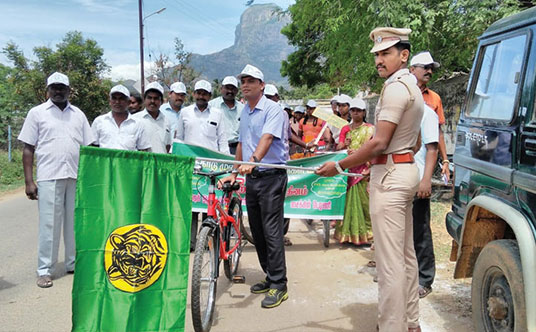
Village Forest Committees were established with one male and one female adult member from one household, each members paid a membership fee of Rs.1/- per month to be a member. Three types of activities were identified and agreed by the VFC members, they are
(a) The Red group people were mainly provided with alternative livelihood
(b)Yellow group with energy saving and efficient methods so that their dependence on the head loads a fire wood remover supplies to them is checked
(c) The green group people were provided activities aiming at enhancing greenery and establishing trees as instruments of economic gains over a period of time.Certain new initiatives have been taken for the first time under the project. The salient features of these VFC initiatives can be summarized as follows.
1. The VFCs are registered under the Tamil Nadu Societies Act 1975 and thus become a statutory body attracting the provision of the Act.
2. The various eco-development activities as envisaged in the micro-plan are implemented by the VFC. The project staff and the NGOs act as facilitators for the micro-plan implementation. The State Government’s decision in this regard permit disbursement of funds to VFCs for implementing the micro-plan is historical and now works as a model. The funds for implementing the micro-plan activities are released to the joint account of the VFC held by the VFC chairman and the member secretary of the VFC (the project staff).
3. No activity carried out under the project is absolutely free. The VFC members contribute 25% or even more of the cost of all activities. The contribution many a times comes in the form of kind, if not in cash. This brings a sense of attachment to the activities carried out under the project.
4. All assistance is provided under the project to identified beneficiaries through the project under alternate employment generation works. The loan amount is recovered with a simple interest (@ 12% p.a.). These funds are managed by the VFC as a revolving fund making the VFCs to provide assistance to local people on a sustainable basis.
5. Rs.50,000 per VFC released as 1st instalment for implementation of the micro plan and based on the implementation of the capacity of the VFC, further releases were made. Seed money was deposited in the bank accounts of each committee. Financial assistances were given to the individual forest dependents and also to the Self Help Groups. To ensure transparency, funds are released from VFC account only with the approval of the VFC.
For successful implementation of VFC several Training programs were organised for VFC members, field level forest staff, target village people. Various social media and culturally relevant techniques such as street plays, folk dance, puppet shows were used by the local volunteers in spreading awareness. Microcredit were given to individuals as well as to self-help groups for starting microenterprises as sustainable alternated livelihood options, 61 different Micro enterprises were started by the people.

Based on the active consultation and information collected, an eco-development micro-plan is prepared in the local language and approved. The micro-plan contains three major components.
